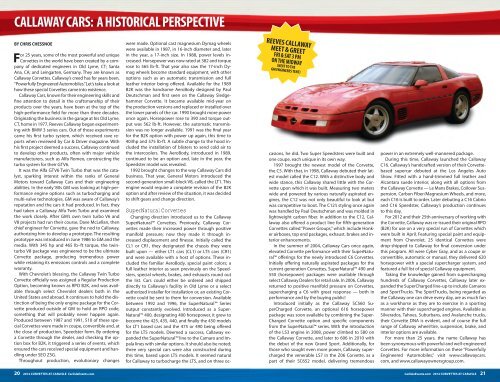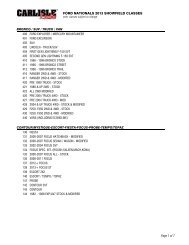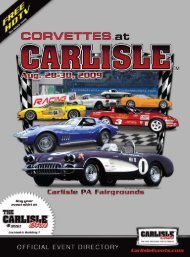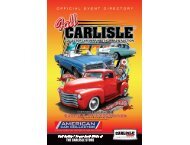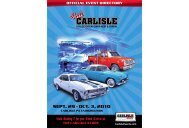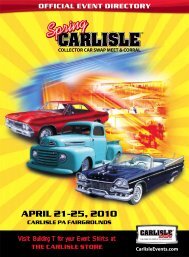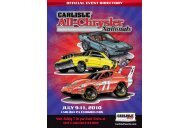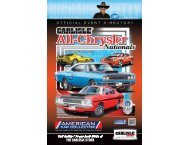vendors by name - Carlisle Events
vendors by name - Carlisle Events
vendors by name - Carlisle Events
- No tags were found...
You also want an ePaper? Increase the reach of your titles
YUMPU automatically turns print PDFs into web optimized ePapers that Google loves.
CALLAWAY CARS: A HISTORICAL PERSPECTIVE<br />
BY CHRIS CHESSNOE<br />
For 25 years, some of the most powerful and unique<br />
Corvettes in the world have been created <strong>by</strong> a company<br />
of dedicated engineers in Old Lyme, CT; Santa<br />
Ana, CA; and Leingarten, Germany. They are known as<br />
Callaway Corvettes. Callaway’s creed has for years been,<br />
“Powerfully Engineered Automobiles.” Let’s take a look at<br />
how these special Corvettes came into existence.<br />
Callaway Cars, known for their engineering skills and<br />
fi ne attention to detail in the craftsmanship of their<br />
products over the years, have been at the top of the<br />
high-performance fi eld for more than three decades.<br />
Originating the business in the garage at his Old Lyme,<br />
CT, home in 1977, Reeves Callaway began experimenting<br />
with BMW 3 series cars. Out of those experiments<br />
came his fi rst turbo system, which received rave reports<br />
when reviewed <strong>by</strong> Car & Driver magazine. With<br />
his fi rst project deemed a success, Callaway continued<br />
to develop other products, often with major vehicle<br />
manufacturers, such as Alfa Romeo, constructing the<br />
turbo system for their GTV6.<br />
It was the Alfa GTV6 Twin Turbo that was the catalyst,<br />
sparking interest within the ranks of General<br />
Motors toward Callaway Cars and their engineering<br />
abilities. In the early ‘80s GM was looking at high-performance<br />
engine options such as turbocharging and<br />
multi-valve technologies. GM was aware of Callaway’s<br />
reputation and the cars it had produced. In fact, they<br />
had taken a Callaway Alfa Twin Turbo and examined<br />
the work closely. After GM’s own twin turbo V6 and<br />
V8 projects had run their course, Dave McLellan, then<br />
chief engineer for Corvette, gave the nod to Callaway,<br />
authorizing him to develop a prototype. The resulting<br />
prototype was introduced in June 1986 to GM and the<br />
media. With 345 hp and 465 lb–ft torque, the twinturbo<br />
V8 package was engineered to be the ultimate<br />
Corvette package, producing tremendous power<br />
while retaining its emissions controls and a complete<br />
warranty.<br />
With Chevrolet’s blessing, the Callaway Twin Turbo<br />
Corvette offi cially was assigned a Regular Production<br />
Option, becoming known as RPO B2K, and was available<br />
through select Chevrolet dealers both in the<br />
United States and abroad. It continues to hold the distinction<br />
of being the only engine package for the Corvette<br />
produced outside of GM to hold an RPO code,<br />
something that will probably never happen again.<br />
Produced between 1987 and 1991, 510 of these special<br />
Corvettes were made in coupe, convertible and, at<br />
the close of production, Speedster form. By ordering<br />
a Corvette through the dealer, and checking the option<br />
box for B2K, it triggered a series of events, which<br />
ensured the cars received special equipment and handling<br />
under SEO Z5G.<br />
Throughout production, evolutionary changes<br />
were made. Optional cast magnesium Dymag wheels<br />
were available in 1987, in 16-inch diameter and, later<br />
in the year, a 17-inch size. In 1988, power levels increased.<br />
Horsepower was now rated at 382 and torque<br />
rose to 565 lb-ft. That year also saw the 17-inch Dymag<br />
wheels become standard equipment, with other<br />
options such as an automatic transmission and full<br />
leather interior being off ered. Available for the 1989<br />
B2K was the handsome AeroBody designed <strong>by</strong> Paul<br />
Deutschman and fi rst seen on the Callaway Sledgehammer<br />
Corvette. It became available mid-year on<br />
the production versions and replaced or installed over<br />
the lower panels of the car. 1990 brought more power<br />
once again. Horsepower rose to 390 and torque output<br />
was 562 lb-ft. However, the automatic transmission<br />
was no longer available. 1991 was the fi nal year<br />
for the B2K option with power up again, this time to<br />
403hp and 575 lb-ft. A subtle change to the hood included<br />
the installation of blisters to send cold air to<br />
the intercoolers. The AeroBody, introduced in 1989,<br />
continued to be an option and, late in the year, the<br />
Speedster model was revealed.<br />
1992 brought changes to the way Callaway Cars did<br />
business. That year, General Motors introduced the<br />
second-generation small-block V8, called the LT1. This<br />
engine would require a complete revision of the B2K<br />
option and after review of the situation, it was decided<br />
to shift gears and change direction.<br />
SuperNatural Corvettes<br />
Changing direction introduced us to the Callaway<br />
SuperNatural Corvettes. Previously, Callaway Corvettes<br />
made their increased power through positive<br />
manifold pressure; now they made it through increased<br />
displacement and fi nesse. Initially called the<br />
CL1 or CR1, they designated the chassis they were<br />
built upon — either LT1 cars (CL1) or LT5 cars (CR1)<br />
and were available with a host of options. These included<br />
the familiar AeroBody, special paint colors; a<br />
full leather interior as seen previously on the Speedsters,<br />
special wheels, brakes, and exhausts round out<br />
the list. Cars could either be ordered and shipped<br />
directly to Callaway’s facility in Old Lyme or a select<br />
authorized installer for installation or, an existing Corvette<br />
could be sent to them for conversion. Available<br />
between 1992 and 1996, the SuperNatural Series<br />
output constantly evolved. Introduced as a Super-<br />
Natural 400, designating 400 horsepower, it grew to<br />
become the 425, 435, 440, and fi nally the 450 models<br />
for LT1 based cars and the 475 or 490 being off ered<br />
for the LT5 models. Deemed a success, Callaway expanded<br />
the SuperNatural line to the Camaro and Impala<br />
lines with similar options. It should also be noted;<br />
three very special cars were also constructed during<br />
this time, based upon LT5 models. It seemed natural<br />
for Callaway to turbocharge the LT5, and on three oc-<br />
REEVES CALLAWAY<br />
MEET & GREET<br />
FRI & SAT 3 PM<br />
ON THE MIDWAY<br />
(NEXT TO THE<br />
GM ENGINEERS TENT)<br />
casions, he did. Two Super Speedsters were built and<br />
one coupe, each unique in its own way.<br />
1997 brought the newest model of the Corvette,<br />
the C5. With that, in 1998, Callaway debuted their latest<br />
model called the C12. With a distinctive body and<br />
wide stance, this Callaway shared little with the Corvette<br />
upon which it was built. Measuring two meters<br />
wide and powered <strong>by</strong> various naturally aspirated engines,<br />
the C12 was not only beautiful to look at but<br />
was competitive to boot. The C12’s styling once again<br />
was handled <strong>by</strong> Paul Deutschman and was molded in<br />
lightweight carbon fi ber. In addition to the C12, Callaway<br />
also off ered a product line for fi fth-generation<br />
Corvettes called “Power Groups,” which include Honker<br />
airboxes, top end packages, exhaust, brakes and interior<br />
enhancements.<br />
In the summer of 2004, Callaway Cars once again,<br />
elevated Corvette performance with their SuperNatural<br />
off erings for the newly introduced C6 Corvettes.<br />
Initially off ering naturally aspirated packages for the<br />
current generation Corvettes, SuperNatural 490 and<br />
550 (horsepower) packages were available through<br />
select Callaway Dealers for retail sale. In 2006, Callaway<br />
returned to positive manifold pressure on Corvettes,<br />
supercharging a C6 with great response — both in<br />
performance and <strong>by</strong> the buying public!<br />
Introduced initially as the Callaway SC560 SuperCharged<br />
Corvette, an optional 616 horsepower<br />
package was soon available <strong>by</strong> combining the Super-<br />
Charged Corvette option and specifi c components<br />
from the SuperNatural series. With the introduction<br />
of the LS3 engine in 2008, power climbed to 580 on<br />
the Callaway Corvette, and later to 606 in 2010 with<br />
the debut of the new Grand Sport. Additionally, for<br />
those who sought even more power, Callaway supercharged<br />
the venerable LS7 in the Z06 Corvette, as a<br />
part of their SC652 model, delivering tremendous<br />
power in an extremely well-mannered package.<br />
During this time, Callaway launched the Callaway<br />
C16. Callaway’s handcrafted version of their Corvettebased<br />
supercar debuted at the Los Angeles Auto<br />
Show. Fitted with a hand-trimmed full leather and<br />
Alcantara suede interior, along with all options from<br />
the Callaway Corvette — Le Mans Brakes, Coilover Suspension,<br />
Carbon Fiber/Magnesium Wheels, and more,<br />
each C16 is built to order. Later debuting a C16 Cabrio<br />
and C16 Speedster, Callaway’s production continues<br />
to this day.<br />
For 2012 and their 25th anniversary of working with<br />
the Corvette, Callaway was re-issued their original RPO<br />
(B2K) for use on a very special run of Corvettes which<br />
were built in April. Featuring special paint and equipment<br />
from Chevrolet, 25 identical Corvettes were<br />
drop-shipped to Callaway for fi nal conversion under<br />
this program. All were Cyber Gray, and as a coupe or<br />
convertible, automatic or manual, they delivered 620<br />
horsepower with a special supercharger system, and<br />
featured a full list of special Callaway equipment.<br />
Taking the knowledge gained from supercharging<br />
hundreds of Callaway Corvettes, Callaway later expanded<br />
the SuperCharged line-up to include Camaros<br />
and SportTrucks. The SportTrucks, being regarded as<br />
the Callaway one can drive every day, are as much fun<br />
as a workhorse as they are to exercise in a sporting<br />
manner with their supercharged engines. Available as<br />
Silverados, Tahoes, Suburbans, and Avalanche trucks,<br />
their Corvette DNA is evident, and of course the full<br />
range of Callaway wheel/tire, suspension, brake, and<br />
interior options are available.<br />
For more than 25 years, the <strong>name</strong> Callaway has<br />
been synonymous with powerful and well-engineered<br />
Corvettes. For more information on these “Powerfully<br />
Engineered Automobiles,” visit www.callawaycars.<br />
com, and www.callawayownersgroup.com.<br />
20 2012 CORVETTES AT CARLISLE <strong>Carlisle</strong><strong>Events</strong>.com <strong>Carlisle</strong><strong>Events</strong>.com 2012 CORVETTES AT CARLISLE 21


